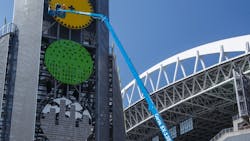Genie Extends Cable Replacement Protocol for Boomlifts
Genie has announced a revised protocol for cable replacement on its cable-operated telescopic booms – the Genie S-60/S-65, S-80/S85, S-100/S125, SX-135 XC, SX-a50 and SX-180 models. Moving from a required 10-year replacement cycle, the updated protocol calls for a mandatory 12-year inspection of the boom extend/retract cables, which are the main components responsible for the extension and retraction of the boom tubes. With the new protocol, replacement is only required if the cables do not pass inspection.
The updated protocol offers Genie customers more equipment uptime and a lower cost of ownership over the potential life of a cable-operated boom, Genie said.
“With rental equipment constantly going out and coming in, less time in the shop translates to more time out on rent,” said Bob Bartley, Genie senior director of product support and reconditioning, Terex AWP. “This revised protocol replaces the mandatory cable replacement process with an inspection-only procedure, reducing maintenance time and costs. This change could significantly decrease our customers’ total cost of ownership, driving a higher rental return on invested capital.”
On cable-operated booms, the boom extend/retract functions should operate smoothly and be free of hesitation, jerking and unusual noise under normal use and service. During the 12-year inspection, if the cables pass inspection, no replacement is necessary, and the machine can go back out on rent. Once the 12-year inspection is completed, the new protocol requires that the cables receive additional inspections every three years to monitor the wear. Bartley said that at any time the cables don’t pass inspection, replacement is still mandatory.
“Regular inspections and proper adjustments of the boom extend/retract cables are important for reliable machine performance and safe operation,” Bartley said. “Owners and operators are responsible for all preventive maintenance tasks outlined in the operator and service manuals provided with every piece of Genie equipment. This extended protocol does not replace the quarterly and annual procedures recommended by Genie.”
About the Author
Michael Roth
Editor
Michael Roth has covered the equipment rental industry full time for RER since 1989 and has served as the magazine’s editor in chief since 1994. He has nearly 30 years experience as a professional journalist. Roth has visited hundreds of rental centers and industry manufacturers, written hundreds of feature stories for RER and thousands of news stories for the magazine and its electronic newsletter RER Reports. Roth has interviewed leading executives for most of the industry’s largest rental companies and manufacturers as well as hundreds of smaller independent companies. He has visited with and reported on rental companies and manufacturers in Europe, Central America and Asia as well as Mexico, Canada and the United States. Roth was co-founder of RER Reports, the industry’s first weekly newsletter, which began as a fax newsletter in 1996, and later became an online newsletter. Roth has spoken at conventions sponsored by the American Rental Association, Associated Equipment Distributors, California Rental Association and other industry events and has spoken before industry groups in several countries. He lives and works in Los Angeles when he’s not traveling to cover industry events.
